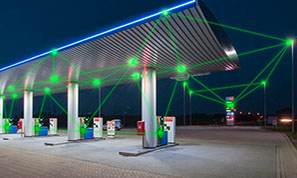Our offer
Arké offers energy efficiency services through the supply of the latest systems of LED lighting, for illumination, decoration and visual communication in general, guaranteeing an energy consumption up to between 65% and 90% lower than with traditional forms of low energy and neon lighting.
Arké offers companies and Public Administrations, offices and institutions an analysis on which to design a new lighting system which is both aesthetically pleasing and constructed with sustainable quality products, as well as the following services:
- site inspection
- technical evaluation of existing lighting
- technical and economic report, business plan with calculation of times of return on investment;
- supply and installation of lamps and related equipment;
- final testing;
- remote control monitor through customised software package;
- paper work for GSE to obtain “Certificati Bianchi”.
Arké aims to find the right balance between quality and energy efficiency, developing made-to-measure solutions, by examining the client’s specific needs and requests, without losing sight of the objective of better lighting both for the individual and the surrounding area.
Energy savings
Thanks to the power of the LED lamps and bulbs it is also possible to substitute fluorescent lighting with LED lamps of the same strength but considerably lower energy consumption being of fewer Watts, thereby ensuring notable reductions in cost.
For example, it is possible to substitute a normal neon 40 W light bulb (type T8 26mm in diameter and 120cm in length) with a LED tube (composed of nearly 300 tiny led elements) that consumes under 17W.
How it works
LED is an electronic component that, by means of a minimum current, immediately emits a bright light without infrared and ultraviolet. LED technology (light emitting diodes) represents the evolution of solid state illumination, in which the generation of light is obtained through semi-conductors rather than through filament or gas. From the point of view of energy consumption, LED illumination is more efficient, longer-lasting and more sustainable. Moreover, it lends itself to creative uses that integrate the light in our homes, cars, shops and cities.
LED lighting is destined over time to replace traditional incandescent and fluorescent lighting.
Duration
LED lights still have 70% of their initial luminosity after 50,000 hours, according to the EN50107 standards.
If we compare the duration of LED lighting with that of tradition lamps and assume an average use of six hours per day we find that:
- Average life of a filament light is roughly 1000/1500 hours (250 days);
- Average life of a discharge light is roughly 4,000 hours (666 days);
- Average life of a fluorescent light is roughly 6,000 hours (1,000 days);
- Average life of a LED light is roughly 50,000 hours (8,333 days).
High Lighting Efficiency
The luminous efficiency of a light source is the ratio between the luminous flow and incoming power. This dimension is expressed in lumen/watt. The luminous flow is defined on the basis of the subjective perception of the average human eye and corresponds to a particular curve within the spectrum of visible light. The light bulb also emits radiations outside the visible band, generally infrared and ultra violet that do not contribute to the sensation of luminosity. A light bulb is more efficient in relation to its ability to remain within the spectrum visible to the human eye.
Currently a LED light has a luminous efficiency of up to 120lm/W, compared with:
- 13lm/W for incandescent bulbs;
- 16lm/W for halogen bulbs;
- 50 lm/W for fluorescent bulbs.
Environmentally friendly
LED lights contain silicon powder, but no noxious gasses or toxic substances, unlike fluorescent and discharge lighting (metallic halogen and sodium vapours).
Total absence of luminous pollution: LED lights shine, but do not saturate the environment.
Zero U.V emissions can be harmful for humans after long periods of time.
Another reason to use LED for commercial premises, especially in clothing and fur outlets, is that long exposition to the above mentioned types of illumination can lead to the hardening and fading of materials, especially natural fibres.
No emission of heat from LED
LED lights generate heat but do not retain this heat; in fact, the bulb itself is capable of controlling the heat generated and disposing of it. In this way the electric power is used for illumination only, optimising efficiency. The average temperature rarely exceeds 50°. LED lights can, therefore, be installed in contact with wood, plastic and all other materials considered unsuitable for exposure to excessive heat.
Notable gains should arrive from saving on air conditioning a well lit room: indeed, a halogen or incandescent lamp produces a considerable quantity of heat dispersed in the surrounding area, and normally when calculation is made for the installation of air conditioning, it is considered as a sources of heat to lower by/to roughly 75W.
The equivalent light source to LED is reckoned to have a margin of redundancy of around 15 W.
Low Maintenance
The cost of maintenance of LED lighting has been estimated to be in the order of one hundred times less than is the case with the sodium plants currently in use, hence virtually non-existent.
Compatibility with all types of connections
The types of LED lighting on sale are compatible with connections in current use in terms of size, plugs and tension : all you need to do is screw the new light into the fitting and bingo!
Our clients
Arké proposes LED solutions for every type of client: public administrations, condominiums, private homes, public spaces, shopping centres, shops and offices.
arkesrl@guidogroup.com PEC: info-arke@legalmail.it
C.F. - P.IVA: 03371190780
webdesign SkillGrafica
Registered office: Via L. Ariosto, 3 - 87100 - COSENZA (Italy) - tel. +39 0984 466654
North Italy operative branch: via Tonale, 9 - 20125 - MILANO - tel. +39 02 39289261
Central Italy operative branch: via Sante Bargellini, 4 - 00157 - ROMA - tel. +39 06 83952370
E.S.Co. Arké S.r.l.
PRIVACY POLICY


